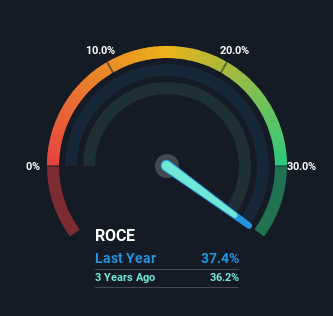- Saudi Arabia
- /
- Oil and Gas
- /
- SASE:2222
The Returns On Capital At Saudi Arabian Oil (TADAWUL:2222) Don't Inspire Confidence

What trends should we look for it we want to identify stocks that can multiply in value over the long term? Ideally, a business will show two trends; firstly a growing return on capital employed (ROCE) and secondly, an increasing amount of capital employed. This shows us that it's a compounding machine, able to continually reinvest its earnings back into the business and generate higher returns. Looking at Saudi Arabian Oil (TADAWUL:2222), it does have a high ROCE right now, but lets see how returns are trending.
Understanding Return On Capital Employed (ROCE)
If you haven't worked with ROCE before, it measures the 'return' (pre-tax profit) a company generates from capital employed in its business. The formula for this calculation on Saudi Arabian Oil is:
Return on Capital Employed = Earnings Before Interest and Tax (EBIT) ÷ (Total Assets - Current Liabilities)
0.37 = ر.س804b ÷ (ر.س2.4t - ر.س298b) (Based on the trailing twelve months to September 2024).
Therefore, Saudi Arabian Oil has an ROCE of 37%. In absolute terms that's a great return and it's even better than the Oil and Gas industry average of 9.3%.
View our latest analysis for Saudi Arabian Oil

Above you can see how the current ROCE for Saudi Arabian Oil compares to its prior returns on capital, but there's only so much you can tell from the past. If you'd like to see what analysts are forecasting going forward, you should check out our free analyst report for Saudi Arabian Oil .
What Can We Tell From Saudi Arabian Oil's ROCE Trend?
We weren't thrilled with the trend because Saudi Arabian Oil's ROCE has reduced by 33% over the last five years, while the business employed 69% more capital. That being said, Saudi Arabian Oil raised some capital prior to their latest results being released, so that could partly explain the increase in capital employed. The funds raised likely haven't been put to work yet so it's worth watching what happens in the future with Saudi Arabian Oil's earnings and if they change as a result from the capital raise.
In Conclusion...
Bringing it all together, while we're somewhat encouraged by Saudi Arabian Oil's reinvestment in its own business, we're aware that returns are shrinking. And investors may be recognizing these trends since the stock has only returned a total of 21% to shareholders over the last five years. So if you're looking for a multi-bagger, the underlying trends indicate you may have better chances elsewhere.
One more thing, we've spotted 1 warning sign facing Saudi Arabian Oil that you might find interesting.
High returns are a key ingredient to strong performance, so check out our free list ofstocks earning high returns on equity with solid balance sheets.
New: Manage All Your Stock Portfolios in One Place
We've created the ultimate portfolio companion for stock investors, and it's free.
• Connect an unlimited number of Portfolios and see your total in one currency
• Be alerted to new Warning Signs or Risks via email or mobile
• Track the Fair Value of your stocks
Have feedback on this article? Concerned about the content? Get in touch with us directly. Alternatively, email editorial-team (at) simplywallst.com.
This article by Simply Wall St is general in nature. We provide commentary based on historical data and analyst forecasts only using an unbiased methodology and our articles are not intended to be financial advice. It does not constitute a recommendation to buy or sell any stock, and does not take account of your objectives, or your financial situation. We aim to bring you long-term focused analysis driven by fundamental data. Note that our analysis may not factor in the latest price-sensitive company announcements or qualitative material. Simply Wall St has no position in any stocks mentioned.
About SASE:2222
Saudi Arabian Oil
Operates as an integrated energy and chemical company in the Kingdom of Saudi Arabia and internationally.
Excellent balance sheet with acceptable track record.
Similar Companies
Market Insights
Community Narratives



